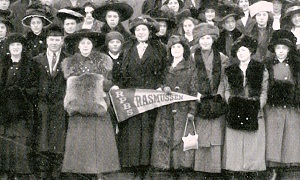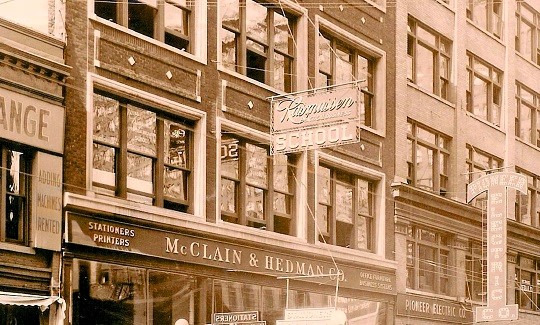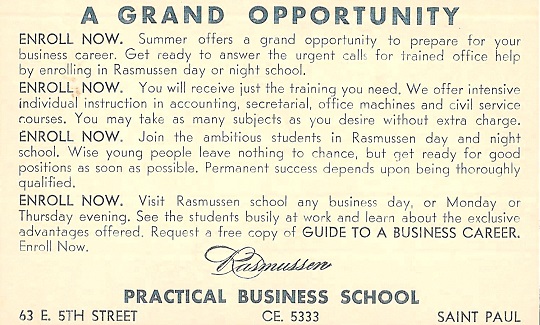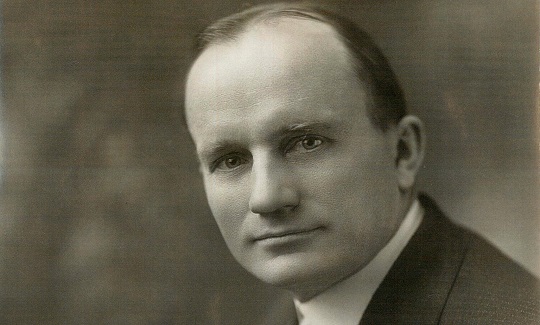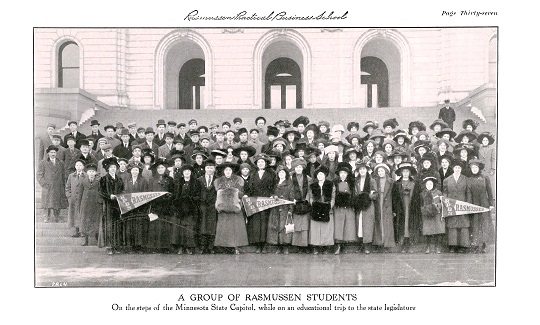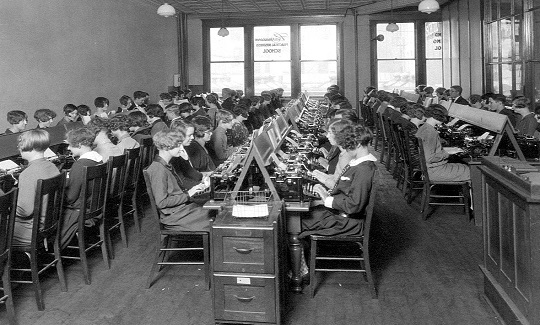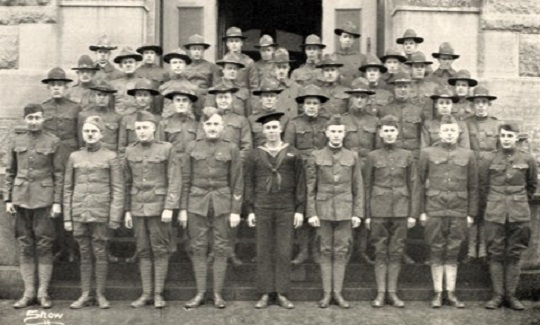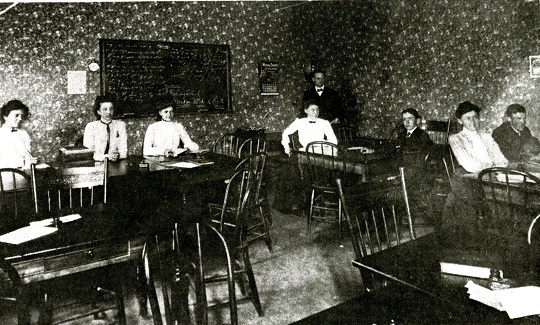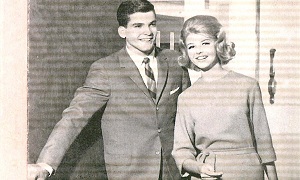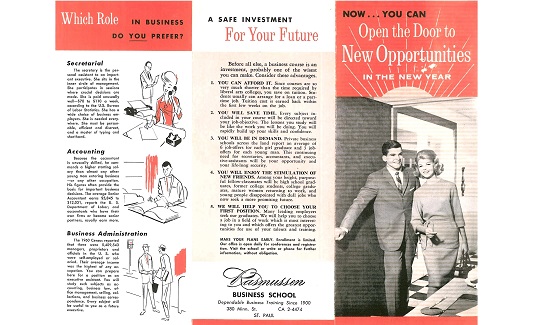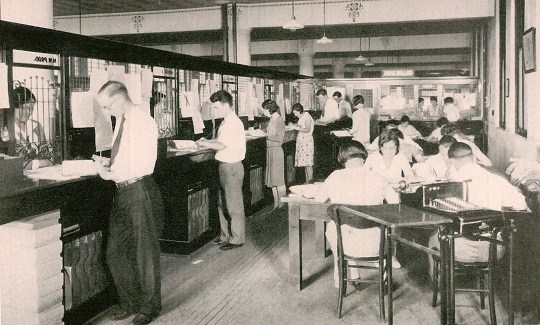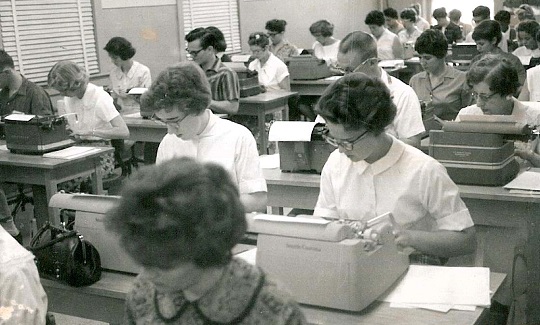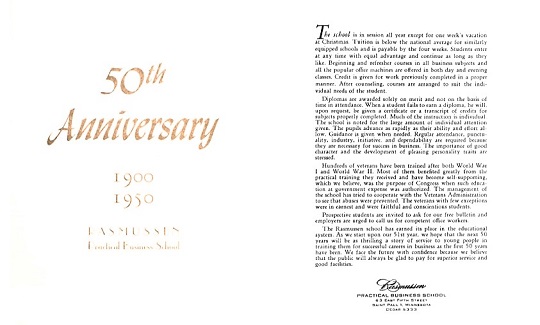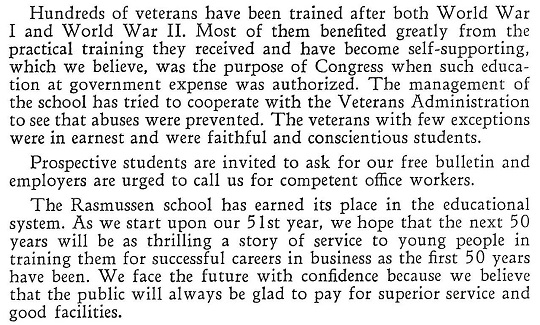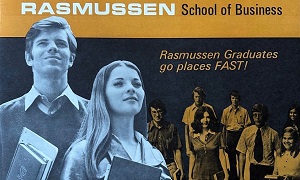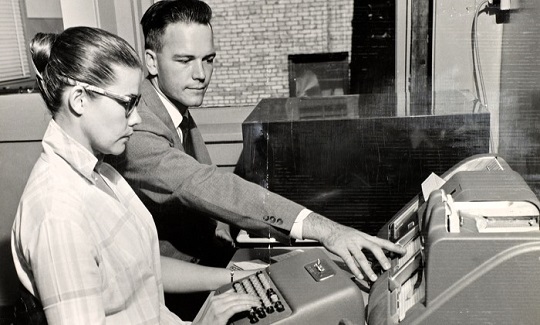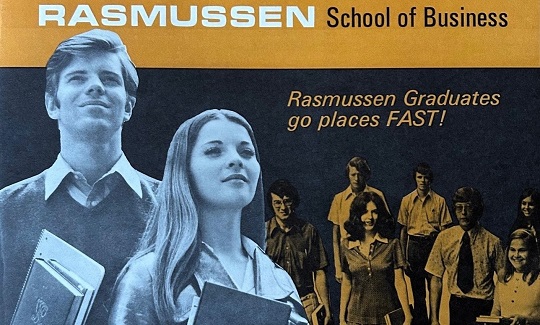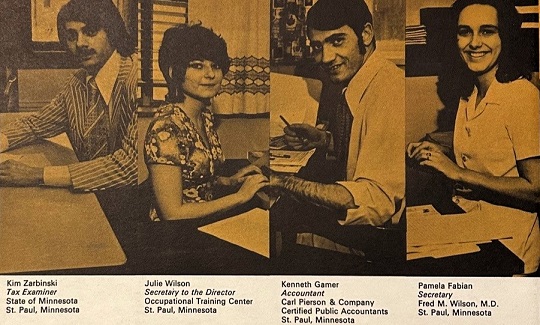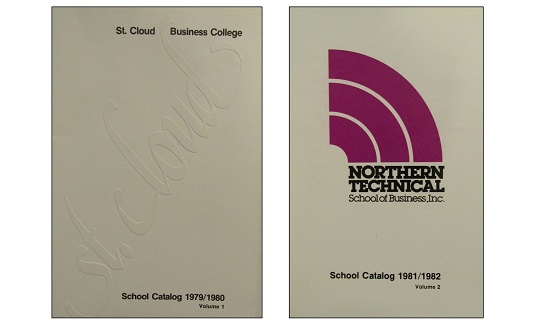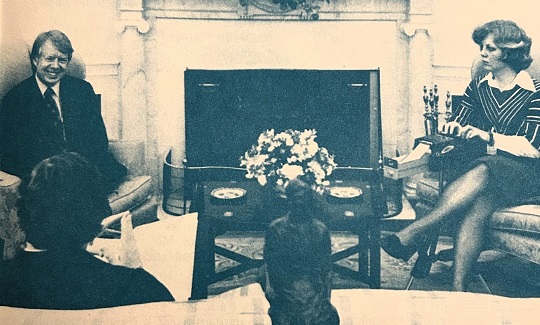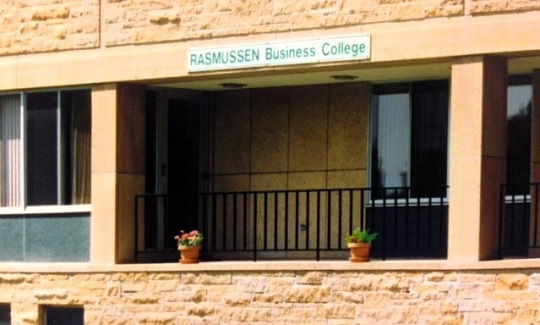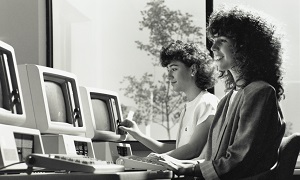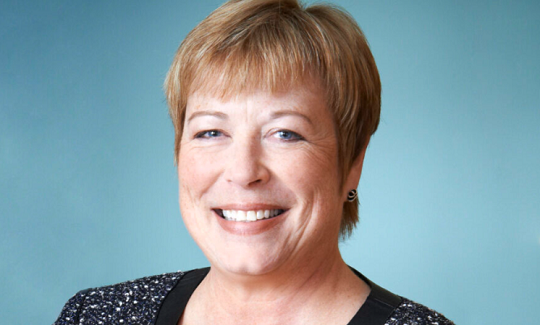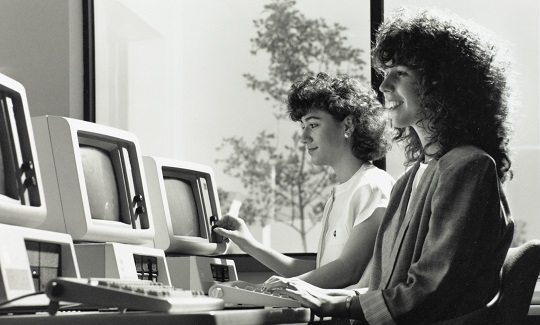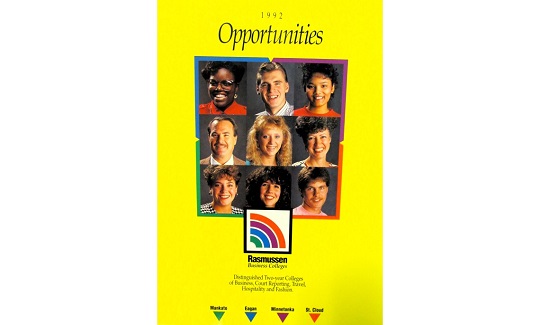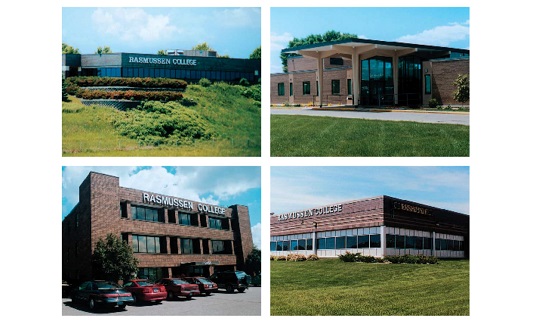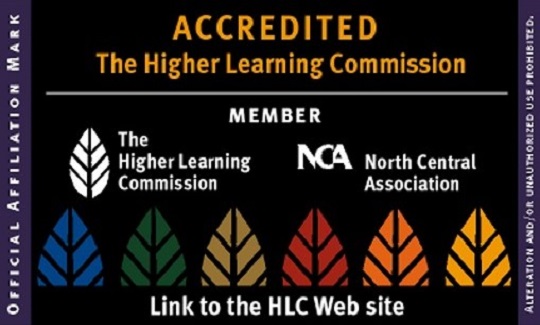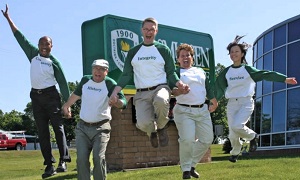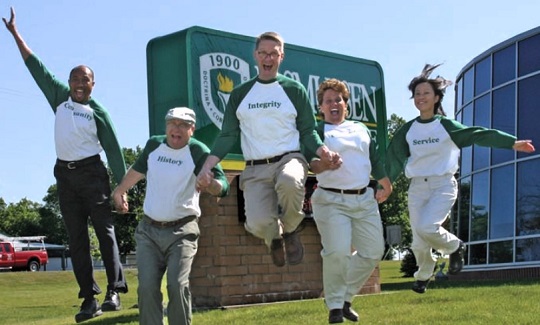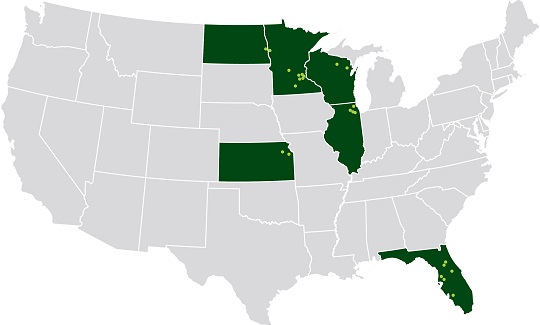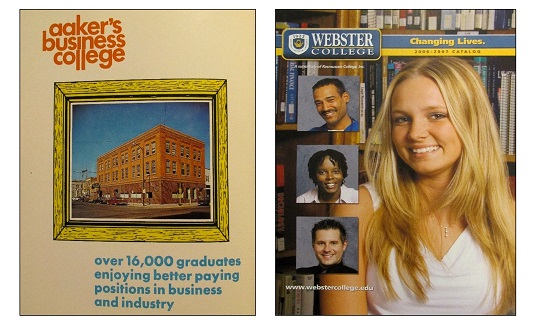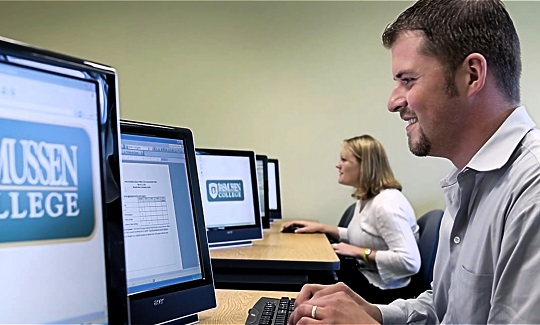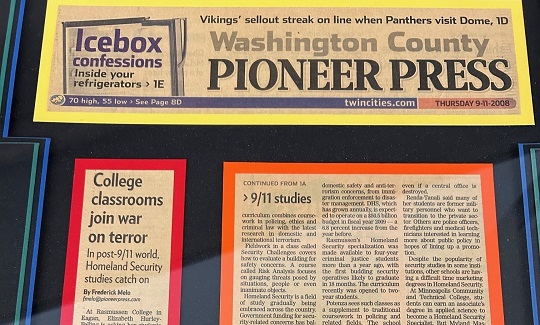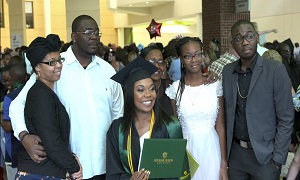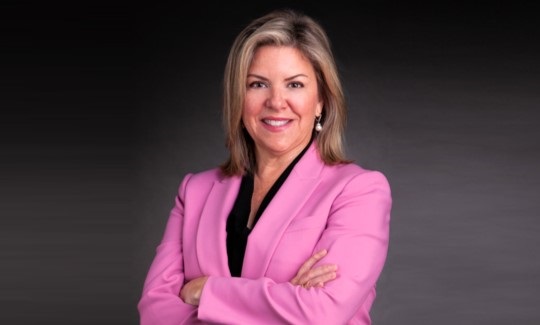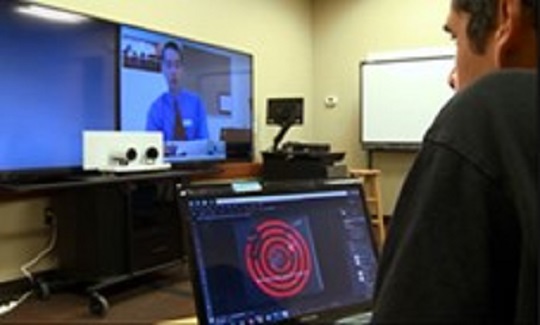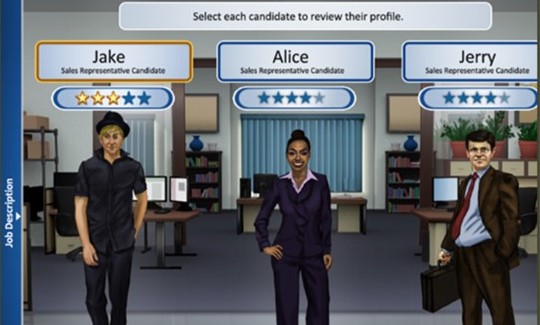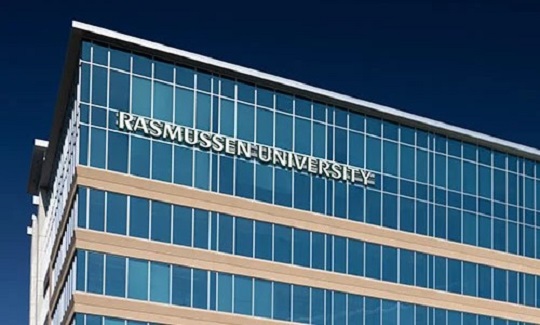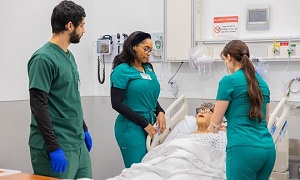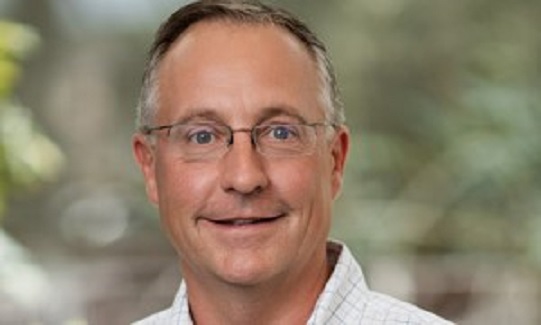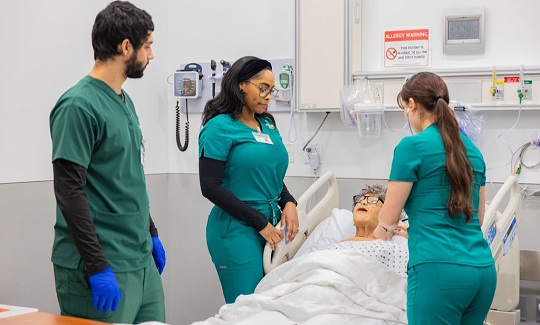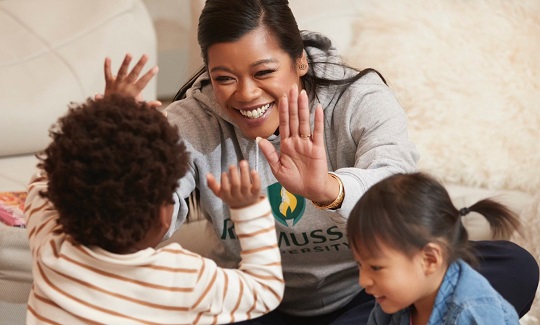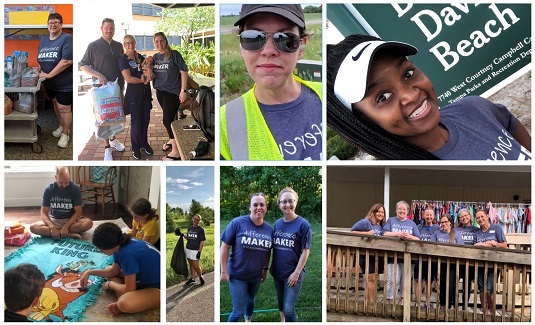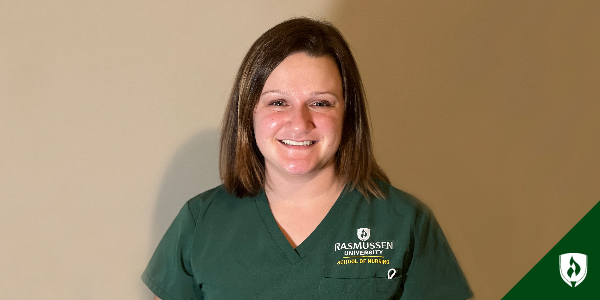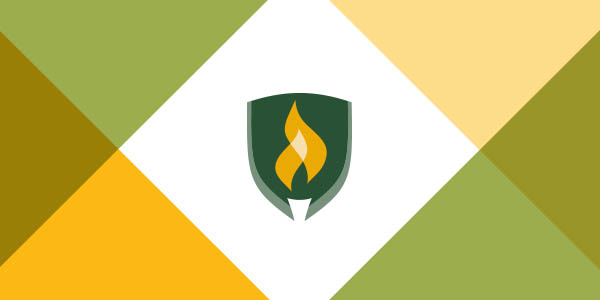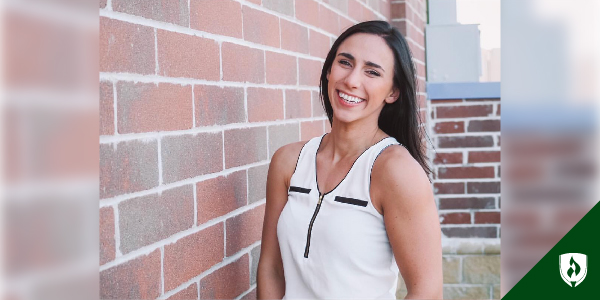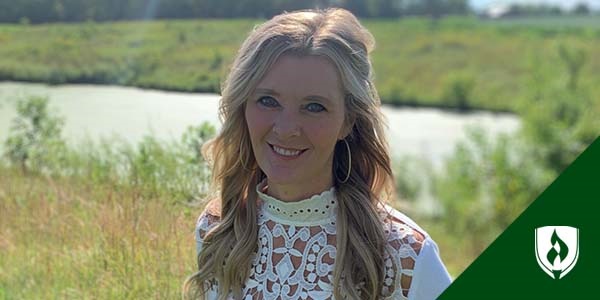
A Legacy of Opportunity
A Path to Success Since 1900
One hundred twenty-five years ago, we opened our doors in St. Paul, Minnesota, to meet the needs of a world facing dramatic transformation—and awesome possibility.
Much has changed since then. Our purpose remains the same. We believe a person-centered, career-focused education is one of the most powerful ways to transform lives, lift families and strengthen communities.
We’ve helped create a path to success for generations of students and provided unwavering support along the way—especially to those underrepresented, underserved and underestimated by traditional higher education.
With every challenge they overcome and every milestone they reach, each of our students is building a legacy. A legacy of opportunity that reminds them how far they’ve come and shows future generations how far they can go.
From 1900 to now and beyond, their legacy is, and will always be, our legacy.
125 years ago, Rasmussen Practical Business School opened its doors in Saint Paul, Minnesota to meet the needs of a world facing dramatic change and boundless opportunity. Much has changed since then, our belief hasn't. From our beginnings in Minnesota to communities across the Midwest and Florida, we have always believed that providing a person-centered, career-focused education is one of the most powerful ways to transform lives, uplift families, and strengthen communities.
Join us as we celebrate 125 years of transforming lives. Together, let's expand possibilities, strengthen communities, and create brighter futures for generations to come. Rasmussen University, a legacy of opportunity. Are you ready?
A Legacy of Opportunity
1900–1944: Answering the Call
On September 1, 1900, the Rasmussen Practical School of Business opened in St. Paul, Minnesota, to meet the needs of a booming “commercial age.”
- Learn more
1900–1944: Answering the Call
”A Grand Opportunity”
On September 1, 1900, the Rasmussen Practical School of Business opened in St. Paul, Minnesota, to meet the needs of a booming “commercial age.” Early promotional material invited students to participate in “A Grand Opportunity” as they prepared for a business career. These opportunities would become critical as the nation recovered from World War I and the Great Depression.
Founder Walter Rasmussen was known as “the father of Gregg Shorthand in the West,” which played a significant role in the institution’s establishment. Coursework included subjects such as shorthand, dictation, typewriting and bookkeeping.
Walter’s brother, Julius Rasmussen, opened an extension of the Rasmussen Practical Business School in Stillwater, Minnesota, which remained open from 1901 until the early 1920s.
The Rasmussen Practical School of Business was a pioneer in providing educational opportunities for all students, including many new Americans and veterans returning from war. By the time the 19th Amendment was ratified in 1920, granting women the right to vote, women had already been learning alongside men since the school’s inception.
- Learn more
1945–1960: Opening Doors for the Post-War Generation
The motto "Open the door to new opportunities" became a guiding principle for the Rasmussen Practical Business School after instructor Walter Nemitz was appointed as Walter Rasmussen’s successor in 1945.
- Learn more
1945–1960: Opening Doors for the Post-War Generation
New Leadership During Dramatic Change
The motto "Open the door to new opportunities" became a guiding principle for the Rasmussen Practical Business School after instructor Walter Nemitz was appointed as Walter Rasmussen’s successor in 1945. Under Nemitz's steady leadership, the school adapted to the country's evolving economic and social landscape, as he regularly engaged with business and community leaders to identify the skills and competencies that were in demand.
Following a second world war, hundreds of veterans benefited significantly from the practical training offered at Rasmussen. The curriculum evolved to address the needs of the post-war economy, incorporating courses in banking, sales and specialized training for civil service examinations.
The school's long-standing commitment to educational technology was demonstrated through substantial investments in electric typewriters and advanced business equipment.
- Learn more
1961–1989: Giving Direction to a Society on the Move
As U.S. families left cities for the suburbs, Walter Nemitz’s sons, Wilbur and Robert, assumed leadership and expanded opportunities for career education in outstate communities across Minnesota.
- Learn more
1961–1989: Giving Direction to a Society on the Move
Becoming a College in a Period of Intrastate Expansion
As U.S. families left cities for the suburbs, Walter Nemitz’s sons, Wilbur and Robert, assumed leadership and expanded opportunities for career education in outstate communities across Minnesota. In the 1970s, Rasmussen acquired the St. Cloud Business College and the Northern Technical School of Business in Minnetonka, Minnesota. A new campus was opened in Mankato, Minnesota, in 1983, and the original St. Paul campus relocated to Eagan, Minnesota, in 1989.
Rasmussen's course offerings evolved to meet the increasing demand for legal secretaries, court reporters and machine operators. “Rasmussen Graduates go places FAST!,” said promotional material. Graduates worked in numerous local businesses, Fortune 500 companies, and even the White House.
The institution began offering its first Associate's degree, which led to a name change to Rasmussen Business College. In 1986, Rasmussen Business College became Minnesota's first proprietary two-year college authorized to award Associate in Applied Science degrees.
- Learn more
1990–2001: Embracing Transformation
With the rise of the internet and breakthroughs in digital technology, Rasmussen swiftly integrated computers into the learning environment.
- Learn more
1990–2001: Embracing Transformation
A Path to Technological Evolution, Accreditation and One Institution
With the rise of the internet and breakthroughs in digital technology, Rasmussen swiftly integrated computers into the learning environment. This included providing laptops to students during this period.
Course catalogs emphasized the “Opportunities” in store for graduates. Programs featured Business, Court Reporting, Travel and Hospitality. In 1994, to reflect the broadening scope of its academic programs, the institution officially changed its name from Rasmussen Business College to Rasmussen College.
Kristi Waite, daughter of Robert Nemitz, took over as President of Rasmussen College in 1997, carrying on her family’s legacy. With her leadership, Rasmussen continued to grow and transform to meet the needs of career-focused students.
In 2001, Rasmussen College was accredited by the Higher Learning Commission, recognizing its high standards and academic quality. This process unified Rasmussen’s various affiliated campuses into one institution with a common catalog and a standardized curriculum.
- Learn more
2002–2013: Expanding Our Reach to Change Lives
As America was reshaped by global events and economic changes, Rasmussen College established new campuses and expanded educational opportunities across six states.
- Learn more
As America was reshaped by global events and economic changes, Rasmussen College established new campuses and expanded educational opportunities across six states. This expansion included mergers with Aaker's College of North Dakota (founded in 1902) and Webster College of Florida (founded in West Virginia in 1922 before expanding to Florida in the 1980s). Both institutions shared Rasmussen's mission of "Changing Lives" by preparing graduates for better-paying jobs in business and industry.
During this decade, two wars and the evolution of the internet (Web 2.0) were significant events, and Rasmussen’s curriculum responded by adding specializations such as Homeland Security and Web Media Production.
Furthermore, Rasmussen broadened its offerings by launching online learning in 2002 and nursing education in 2003. The first Bachelor's degree programs were introduced in 2006. By the mid-2000s, Rasmussen reaffirmed its core values with the acronym CHIPS, which stands for Community, History, Integrity, Placement and Service.
- Learn more
2014–2020: Innovating to Make Career Success Accessible
Rasmussen addressed shifts in U.S. student demographics and rising college debt by focusing on affordability, flexibility and accelerated learning.
- Learn more
2014–2020: Innovating to Make Career Success Accessible
Supporting Students’ Unique Journeys
During this period, Rasmussen addressed shifts in U.S. student demographics and rising college debt by focusing on affordability, flexibility and accelerated learning. When President Waite retired in 2015, Dr. Trenda Boyum became her successor. President Boyum built on her predecessor's efforts by expanding access to high-quality education through innovation.
While many institutions increased tuition, Rasmussen reduced costs for several programs and introduced Competency-Based Education (CBE) through our Flex Choice® learning options, positioning us as a national leader in this approach. We also launched Rasmussen Ready, a free resource designed to enhance college readiness and reduce remediation rates for incoming students.
Technology use flourished, with advancements like nursing simulations and telepresence platforms that allowed instructors and students to connect virtually.
In 2016, we introduced our first graduate programs, and in 2020, Rasmussen College transitioned to Rasmussen University, marking a significant milestone in our commitment to student empowerment and advanced education.
- Learn more
2021–Present: Writing the Next Chapter in Our Legacy Story
Rasmussen enters a new era. What was once a practical business school is now a university with more than half our students enrolled in Nursing and Healthcare programs throughout our network of campuses.
- Learn more
2021–Present: Writing the Next Chapter in Our Legacy Story
New Opportunities for Difference Makers
Rasmussen enters a new era. What was once a practical business school has now transformed into a university, with more than half of our students enrolled in nursing and healthcare programs across our network of campuses. Additionally, we offer convenient and accessible online degree programs in business, design, education, human services, justice studies and technology.
In 2021, Rasmussen University became part of American Public Education, Inc. (APEI), a network of schools dedicated to educating and training military service members, veterans, nurses and other ambitious professionals.
In 2023, Paula Singer became Rasmussen’s president, bringing years of higher education experience and a vision for helping the university reimagine itself. As we begin our 125th year, Singer transitions to Rasmussen’s Board of Directors while we welcome Mark Arnold as president. Arnold brings a growth mindset and an extensive knowledge of the healthcare industry, both of which are crucial for Rasmussen's continued success as we strive to expand opportunities in career-focused fields that address critical workforce needs.
While we write our next chapter, we remain committed to our legacy of supporting "difference makers" who serve our communities, a purpose that is more critical than ever as the demand for nurses and healthcare workers continues to grow.
- Learn more
Upcoming Anniversary Events
We are excited to celebrate Rasmussen University’s 125th anniversary across our 20 campus communities, which have been a vital part of our history and legacy. Check back often for additional events near you, or check your local Facebook group.Commemorative Newspaper
Help us honor our 125th anniversary by checking out our University commemorative edition newspaper. Find inspiring alumni stories, faculty/staff features, messages of thanks from Rasmussen leadership and a brief history timeline.
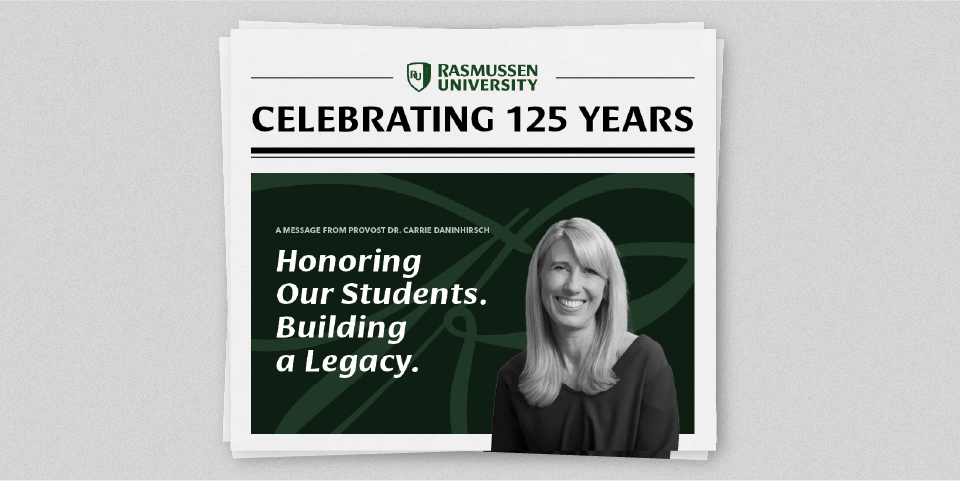
1.25-Mile Anniversary Run/Walk
Let’s celebrate 125 years of education with 1.25 miles of fun! All paces are welcome. Join your community with food, campus/lab tours and more. Five upcoming events in Florida, Minnesota, Illinois and Kansas throughout September 2025.
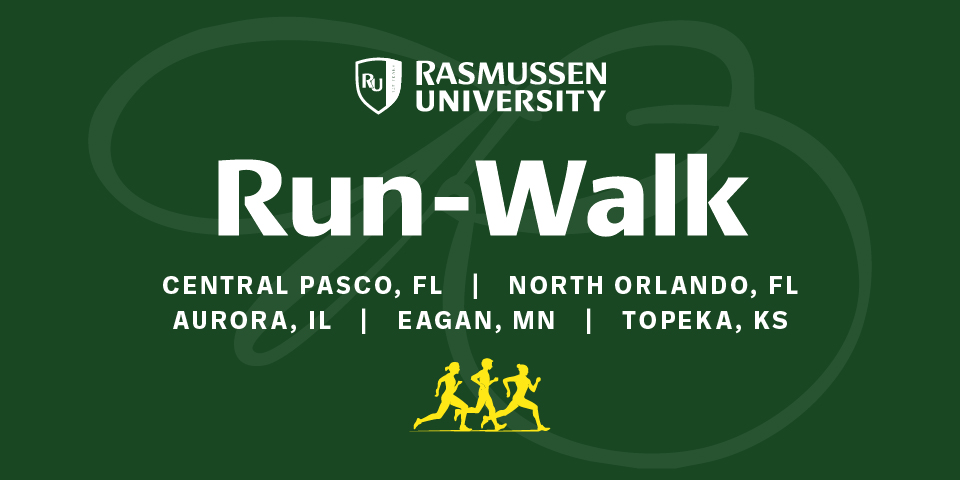
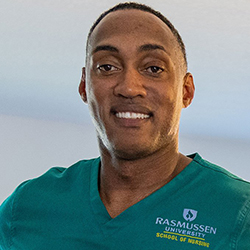
"Prior to me enrolling in Rasmussen, I spent 16 years in the military, 12 in Special Forces as an Army Green Beret… I don't have too many fears in life, but I do fear being forgotten. And I know that if you can do something to make an impact in other people's lives, you know, you leave a legacy."
Arnold
Army Veteran, Cancer Survivor and Bachelor of Science in Nursing Student
Legacy Stories
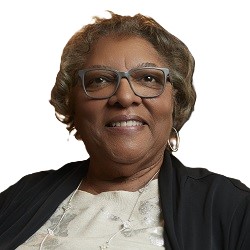
"As a faculty member at Rasmussen for 44 years, it has been an incredible journey filled with meaningful relationships with students and colleagues. It has been deeply rewarding to inspire and guide students, helping them reach their goals and succeed in society. The sense of purpose and fulfillment that comes from contributing to their growth and achievements is immeasurable. It has been an honor to be part of such a transformative and impactful environment for so many years."
Virginia Knox
Assistant Professor
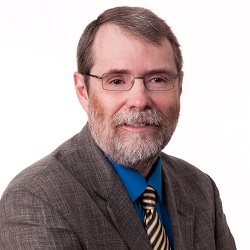
"For 125 years, students have turned to Rasmussen to enhance their lives, earning credentials and degrees to create opportunities for personal growth and success. Our legacy lies in helping students build their legacy, and it extends to our efforts to improve our communities and the lives of those around us through the practical education we provide."
Dr. Matt Segaard
Assistant Vice President Institutional Research & Assessment
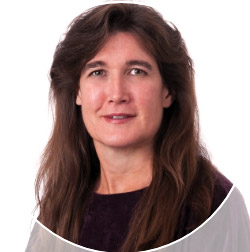
"I’m proud to work for Rasmussen and continue its legacy. For 125 years, it has provided students with an opportunity to create a better life for themselves. Long ago, Rasmussen recognized types of students who could benefit from a different approach to education, as well as, offering programs and skills needed in the workforce. As a result, it has changed the lives of many for the better."
Diane Nemitz
Senior Compliance Officer, Granddaughter of Walter Nemitz and daughter of Wilbur Nemitz
